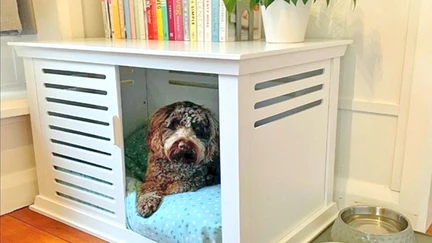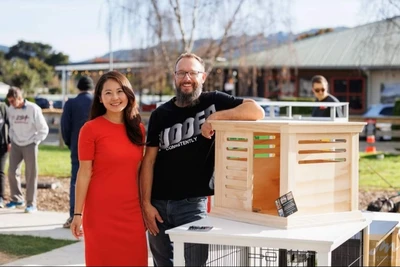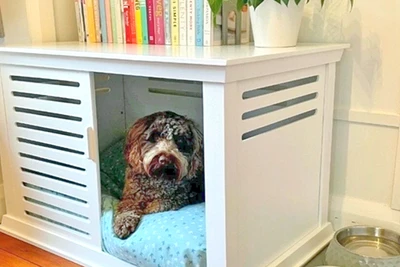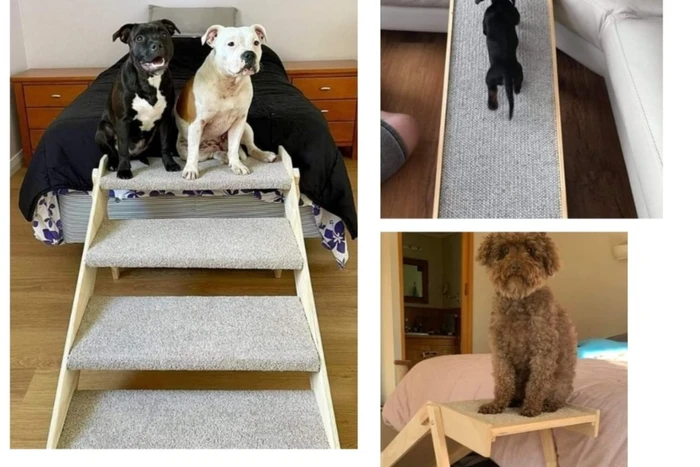Fur-niture with flair : An interview with Bess and Stu of Beloved Pet Furniture
A dog crate prototype and a posting on social media led to Brooklyn couple Stu and Bess becoming accidental entrepreneurs. We talk to them to find out how they developed Beloved Pet Furniture.

Photo courtesy of Beloved Pet Furniture
Approximately 63 percent of New Zealand households include a furry member of the whānau. There are an estimated 1.26 million household cats in NZ, followed closely by an estimated 830,000 dogs.
Because our four legged companions are important to us it’s not surprising we spend on treats for them, making sure they’re well fed and comfortable.
The national cost of the pet market is estimated to be upwards of NZ$1.5 billion. That includes the basics of food, vet bills, registration etc as well as pet accessories and accommodations.
In a quiet corner of Brooklyn, Bess and Stu of Beloved Pet Furniture have tapped into the market. With two dogs, Dave the cat, and a stream of SPCA foster pets (including a cage of rats) they've had some tough customers to satisfy.
We talk to Stu and Bess about turning their pet furniture products into a niche business that provides them with both income and work life balance.

Photo courtesy of Beloved Pet Furniture
WCL: Tell us a bit about who you are and what you make?
Stu: We were both teachers, teaching for over 20 years and we decided that maybe a bit of a change was needed. I’ve always built or made things. Bess saw an idea on line that someone had done around a dog crate and thought it looked quite interesting and asked me if I could make something like that.
So I just basically knocked up a prototype and that’s how we got going.
Bess: He made a crate prototype and then I put it out on a Facebook page to gauge interest and it was amazing. So many people wanted to know more. How much it was, could we custom make them and it went so quickly from there.
We worked very hard right at the beginning to figure out a lot of things. We didn’t plan to go into business. There was no planning, it was spontaneous.
Stu: It was just an extra on the side, a hobby, that gave me something to focus on after work. Then it snowballed a bit ... and I thought “Maybe I can step away from teaching for a while”.
WCL: When did you make that decision to go all out in the business?
Stu: Around 2021.
Bess: Basically within two months of building the prototype.
Stu: Once the first one sold and the idea was seeded that there were other inside pet things that could be made, and the fact that we were going to make them to what people needed, it became obvious there was a niche there to make pet things to order.
People love their pets and they want to make their lives and their pets lives easier. So if someone can help them in that solution, there is money there I suppose.

Photo courtesy of Beloved Pet Furniture
WCL: Once you realised there was a market what did it take to scale it to a productive enterprise?
Bess: We had to be quite careful with that. Having lots of orders is great but you have to remember your time is money.
Stu: It is hard. We did do a cost analysis of everything. I broke down my time and tried to equate going to Bunnings for materials and stuff, and then it becomes about quantity. Really it was aiming at a price that didn’t exclude too many people but you can’t go much cheaper than a certain point.
To find the zone was really quite hard. Recently we have had to keep putting things up a little bit because it’s amazing how the prices have kept creeping up.
Bess: We won’t last long if we don’t change.
Stu: The whole reason it works is that we provide that one service of changing what was available to fit people’s needs.
You can buy ramps, you can buy steps for pets from cheap providers but they come at a set height. As soon as someone has a bigger dog or a higher bed those products aren’t an option. We provide the option to make it exactly what they need. That means people are happy to pay that little bit more because it meets their needs. The feedback has been really good. We’re making a really good product.
In all honesty, the hardest part has been sourcing materials. Materials in New Zealand are very limited and we don’t have a huge market. It’s been trying to find materials that are cheap enough to build with to keep the price down. And there’s not always a lot of options, so we had to try and work it all out using building materials that would go into houses like architraves and skirting boards. Using things for other purposes has been the only way we have managed to do it.
WCL: Bess, are you also full time in the business or do you still teach?
Bess: I still teach but I only do relief teaching. I teach 2-3 days a week. My job is more part time. Stu does all the building and I do everything else. I communicate with customers, do the shipping, marketing, website management. The business is still growing so I must be doing something right!
WCL: How do you find working and living together when there’s little separation between home and the workshop?
Bess: I think in the beginning life and the business were so tightly connected but I feel recently things are a little bit easier now we have processes in place. We know how to do things if something happens. We are better at communicating with each other.
WCL: After you put the original product out there on Facebook marketplace how did you develop the marketing side?
Bess: Once the prototype was put up on Facebook we started to receive messages from people wanting to order privately. That process was fun but very time consuming. I would have ten people messaging me and asking all different questions, yet often the same questions. I realised I needed to have a website which has all the information; all the answers in one place.
We also needed a place where they could pay by credit card rather than me writing an invoice and waiting for them to process it. We tried to keep everything as simple as possible. Within three months of launching the prototype we started a website.
That was a learning process as well. As a small business we didn’t want to go big and pay people to build a big website, because they can be quite expensive and we decided to just give it a go ourselves.
WCL: Do you have plans on expanding your range?
Stu: We try to make just about anything people request. Once I make them, we photograph them and put them on the website. It’s interesting to see what flies and what doesn’t. Everything we make we put other there for others to see and order.
Bess: There are still areas I suppose we haven’t yet explored, such as rat cages.
A while ago we tried the idea of flatpack catios. New Zealanders are more open to the idea of indoor cats these days. That didn’t work. Sometimes we have an idea, we try it and see what happens.
Stu: If I come up with an idea I make a prototype. It’s very easy to give these things a go as a small business. It costs us next to nothing to try and idea.
Bess: I feel the business could go further but it’s about time and energy. We want to have a good work life balance. If we expand further we tip the balance.
Stu: We’re not trying to make millions out of this. It’s not that kind of business. It’s more a life-choice business. It’s got to pay the bills
Bess: And it’s fun as well. I really enjoy being around animals.
Stu: As to the rats and other animals – yeah, we’d be open to what people need.
But with the small animals, we’re fighting the cheap Chinese imports. You can buy a reasonably made, reasonably priced mass produced item. We’re not competitive with that market.
Bess: I need to look deeper. I need to join more rat Facebook pages ...
WCL: What’s your customer distribution? Is it largely Wellington based?
Bess: The majority are from Auckland.
Stu: Yes, Auckland has been very much our major market. Wellington a bit but its not our main market.
Bess: I think it’s something to do with the breeds of dogs. Christchurch has all designer breed dogs. I imagine Auckland is much the same.
Stu: In Wellington, if you go to the dog park, they’re all big dogs that don’t need ramps. Our ramp world is where people have dachshunds and dogs like that.

Photo courtesy of Beloved Pet Furniture
WCL: If an owner orders an item like a ramp, how can they ensure their pet will actually use it?
Bess: When we sell something we want the pets to be happy and use it.
It’s important for us to know as much as possible about each animal. If we know the dog is half blind, with spinal issues we will make sure the ramp is as wide as possible, sometimes with sides so they feel more secure. That way the chances of them using the ramp will be higher
WCL: As your business grows do you plan on taking on staff?
Stu: We have contracted out some of the building work when the orders were flying in, and it sort of worked. We’re a business that falls on the edge of sometimes needing an extra person but often not. It’s actually easier to keep it as an in-house business.
Bess: If you contract out then sometimes the quality may not be what we want and it ends up being a lot more work.
WCL: What’s your turn around for a custom made piece?
Stu: We can generally do a turnaround in two weeks. At the moment it’s weather related because getting paint to dry can take some time. So in winter we slow down a bit.
Bess: We tell customers 3-5 weeks and then deliver earlier.
WCL: Your website emphasises quality and continuous improvement – why are those values important to you?
Bess: People’s needs are always changing. I feel it’s very important for us to keep up with what they really want. We understand our products are not cheap so we want to make sure people are 100 percent satisfied with what they receive.
Stu: Because we do such a bespoke thing we don’t want to send out a bad product.
If someone isn’t happy we will take the product back and refund them or rework it.
Generally we don’t find that though. But we have to accept we can’t satisfy all the people all the time and take on the feedback.
Anything that breaks or is not right we are always happy to fix or replace if possible.
Bess: Even when our product is out there [with a customer] we still want to treat it like ours and look after it and make sure the customer is happy.
WCL: What have been the highs and lows of going into business. Have you had those moments where you wonder what you’re doing?
Bess: Yeah all the time!
Stu: It’s more the things like when someone isn’t happy with something or you’ve sent something and it’s got damaged in transit and you’re left with a problem that hangs over you and you have to deal with it. Those are the bits that are kind of stressful. Then again, you get your processes in place and you learn how to deal with it.
Stresses really, now, are much fewer.
Bess: They’re still there and happen when you’re not expecting them. In the beginning stress came from being disappointed with ourselves and with something that had happened to an order. Right at the beginning if I got an email from a customer saying they weren’t happy or the product had got damaged by the courier it would send me to laying on the sofa for maybe half an hour to recover. Now I just go straight back to the customer and I know what to do. Now I feel this isn’t a big deal, it’s fixable. I have learned that most of our customers have been kind and very supportive as long as we are being honest and genuine about what’s happened.
The stress these days is probably more about keeping on going. Sometimes we get tired. This is our fifth year. Sometimes we do feel like we have to keep on marketing, keep on selling, keep on building.
Stu: It’s easy to fizzle out. Unless you keep your hand up and keep saying “Look, we’re here, we’re here” people forget about you very quickly and you lose business.
Bess does a good job with that. She’s always on Facebook pages communicating with groups who might have an interest in what we do. She’s trying to promote us and what we do and highlighting our points of difference compared to what they can buy off AliExpress.
In the past we’ve done things like expos and they are such a lot of work and really exhausting.
Bess: We did two events like that and both of them left us feeling emptied out for days and days.
Stu: It was hard work and it was hard to know how much we got out of it. When we did the last one we tried to quantify how much time and effort we put in to it and how many orders we think we probably got from it. We probably got a handful of orders and we’ve found that if we hit the right Facebook page we get the same amount of orders.
Bess: Digital marketing works much better for us, because most of our customers are outside Wellington. So reaching them through Facebook ads or google ads is more efficient than physically meeting them.
I’d like to try catshows though ....That’s another one I’d like to look into more.
WCL: Where do you see yourself in another five years
Stu: Such a tough one. I don’t know. I think we’re comfortable where we are. It’s hard to see any major expansion. It sits about right for us at the moment. It’s a nice little business that rolls along. For New Zealand’s size, I don’t think there’s much potential to go massive. We have a saturation point.
There’s huge pet markets out there but sadly New Zealand is so far away from them. We have had enquiries from Australia and America but to ship things is a ridiculous price.
WCL: Any words of advice to anyone thinking of setting up a business in Wellington?
Bess: Making mistakes is ok. Just be honest with yourself and move forward and find a solution.
Stu: It’s the old adage – don’t go too big too fast. Keep it small and make it work. You have to grow it from a small start. We’ve seen a lot of businesses come and go in the last five years.
Bess: They arrived with lots of noise, lots of amazing things, then disappeared.
This is our fifth year and we do enjoy our lives. And we enjoy making a difference to the lives of animals and their owners. It’s a nice feeling.
Interested in learning more about running a small business? Check out these resources from Wellington City Libraries.
- Delighting your customers-- on a shoestring : delivering excellent customer service without breaking the bank by Avril Owton, 2011.
- Value proposition design : how to create products and services customers want by Alexander Osterwalder, 2015. eBook format
- Social media for small business : marketing strategies for business owners by Franziska Iseli, 2021
- Company of one : why staying small is the next big thing for business by Paul Jarvis, 2019. Also available as audiobook
- Make your business survive and thrive! : 100+ proven marketing methods to help you beat the odds and build a successful small or home-based enterprise by Priscilla Y. Huff, 2007.